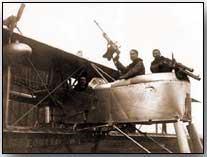The War in the Air - Bombers: France
 France was alone amongst the major belligerents in not developing a
multi-engined bomber during the war, but they were the first on the Western
Front to organize dedicated bomber units. The first bomber group, GB1,
was organized in September of 1914, comprising three Escadrilles (squadrons)
flying Voisin pusher aircraft.
France was alone amongst the major belligerents in not developing a
multi-engined bomber during the war, but they were the first on the Western
Front to organize dedicated bomber units. The first bomber group, GB1,
was organized in September of 1914, comprising three Escadrilles (squadrons)
flying Voisin pusher aircraft.
Carrying a bomb load of about 150 kg (330 lb), the Voisin had a steel frame which made it extremely tough. It remained in production, through many variations, throughout the war. The last variations could carry twice the initial bomb load.
In Commandant Goÿs, GB1 had a brilliant leader and theoretician, who developed the theory and practice of long range bombing sorties. Bomb aiming techniques progressed from an arrangement of three nails hammered into the cockpit, to the use of glass panes in the floor of the aircraft, and then on to bombsights.
They built up target dossiers which were used for carefully planned raids. Goÿs led an almost unopposed bombing campaign during the early months of 1915. On May 26th he led an attack against a poison gas factory near Mannheim. Of the 18 machines taking part, only Goÿs himself failed to return, his Voisin forced down by mechanical failure.
Following the success of GB1 other bomber groups were formed. The French continued to make large daylight bombing raids - with as many as 62 aircraft - throughout the summer and autumn of 1915, but unlike the freedom of the skies they had enjoyed early in the year they were beginning to suffer losses as the Germans gained control of the air during the period known as the "Fokker Scourge".
When accompanied by Nieuport Bebe fighters they were safer, but this limited their range.
One such escort squadron was the escadrille La Fayette. This was a squadron of American volunteer fighter pilots flying for the French. They were attached to bomber group four, flying Maurice Farman bombers, which was commanded by Capitanne Happe.
This charismatic commander had introduced the use of formation flying to increase his bomber's safety, and he led many notable raids. His attack against the Aviatik factory at Freibug-im-Breisgau was so successful that the factory was relocated to Leipzig. During a three plane raid against Rothweil Happe encountered Oswald Boelcke in the air, but managed to fight him off.
After this raid, and much to Happe's own delight, the Germans put a price of 25,000 Marks on his head. He responded by dropping them a note from his aircraft, thanking them and informing them that his aircraft could easily be recognized because he had painted his wheels red.
Despite Happe's bravado, by 1916 the Armee de l'Air was forced to carry out almost all its long range bombing by night. It was only in 1917, when the Breguet 14 appeared at the front, did the French have a potent enough machine to return to daylight bombing. This was one of the first aircraft built that made extensive use of duralumin in the frame, making it extremely strong.
It was also France's first tractor bomber. Its 300hp engine gave it a top speed of 195 km/h (122 mph), slightly faster than the Fokker D VII. It was built in both reconnaissance and bomber varieties, the latter carrying a maximum bomb load of 260kg (570 lb). Over 5,000 were produced during the war, and production continued as late as 1928.
Article contributed by Ari Unikoski
Next - Bombers - Britain
A "Grand Slam" was British slang for an impending attack or battle.
- Did you know?
